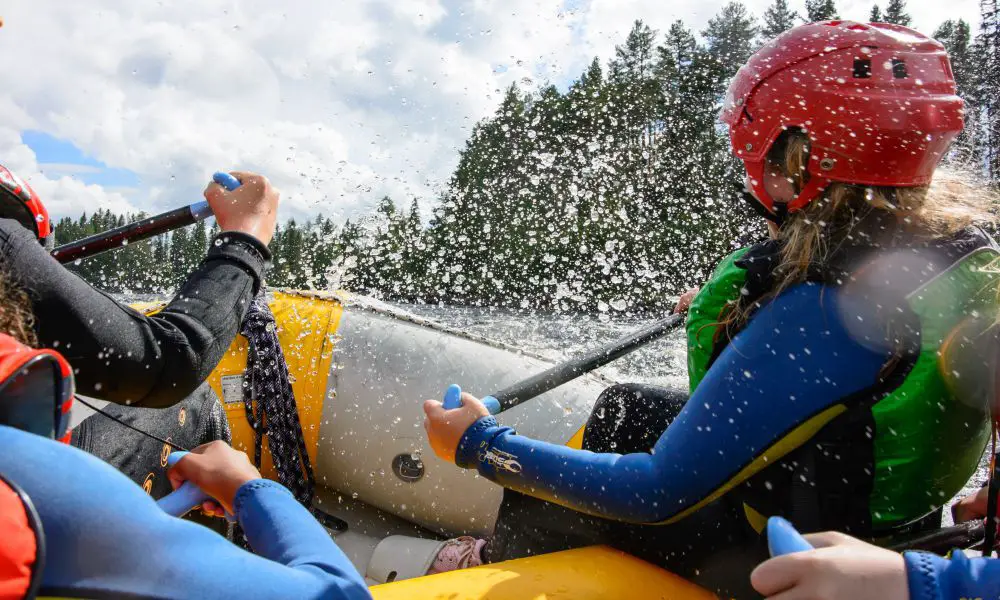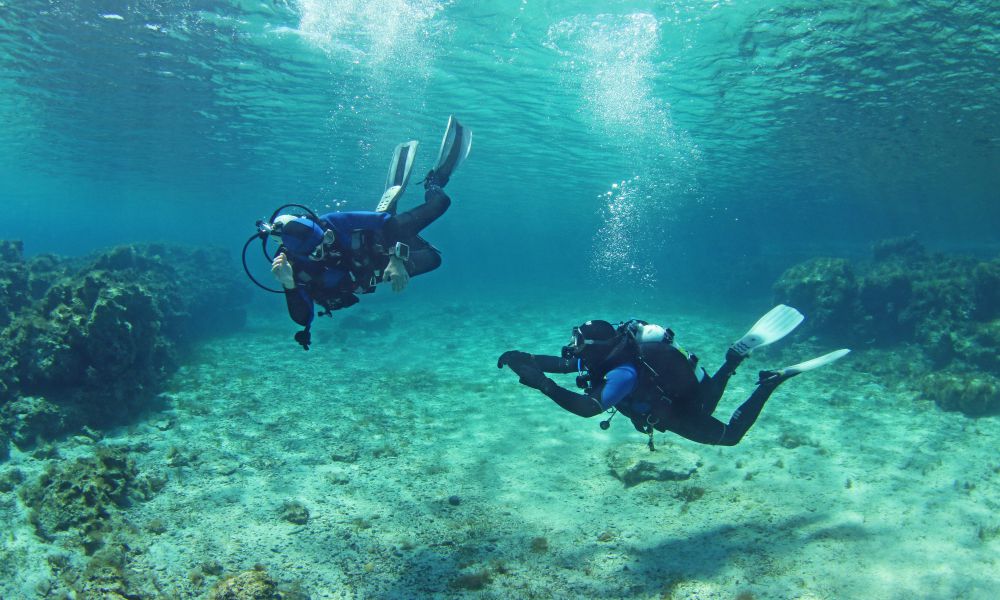Depending on the class of rapids that you decide to follow, whitewater rafting can be an easy or difficult watersport. That’s why you need to know some beginner tips about it.
But know that such beginner tips don’t have to deal with how to do it correctly. Other equally important tips are those that talk about how to choose the correct whitewater rafting gears.
That being said, this article compiles all of the important tips for you to follow. It will talk about tips on choosing whitewater rafts, whitewater paddle, whitewater safety gears, and whitewater rafting safety tips. All of these are the 15 whitewater rafting tips that you won’t find anywhere else.
Tips on Choosing Whitewater Rafts/Boats for Beginners
Your raft/boat is the key player for whitewater rafting. It’s what will take you to the riffles, runs, pools, and tail out. Well-made rafts/boats provide for peerless maneuverability and allow you to ride easily once again in case you fall off. These are the tips that you should remember when looking for a raft/boat for your first-time whitewater rafting cruise.
1. There Must Be a Rope around It
Always look for the presence of a rope that goes around the edges of the raft/boat for whitewater rafting. The rope is important for two reasons. The first reason is that it allows for easy transport even if the whitewater raft/boat isn’t deflated. The second reason is that it allows you to hang on for dear life in case you fall off.
In connection, a whitewater raft/boat that uses webbing instead of a rope is utterly useless. Webbing is more difficult to grab. Moreover, it makes the raft/boat prone to snagging on large obstacles in the middle of the rapids, such as rocks, trees, etc.
2. Don’t Underestimate the Power of Self-Bailing Flooring
Water gets inside the whitewater raft/boat are you’re traversing the rapids with it. Little by little, these will fill the cockpit. Since your busy maneuvering, scooping the water out of the cockpit would be impossible. That’s why the flooring should have a self-bailing function that prevents the cockpit from getting filled up.
Checking if the whitewater raft/boat has self-bailing flooring is easy. All you have to do is to look for tiny holes that are installed with gaskets. Those tiny holes allow the self-bailing function to operate. What they do is suck the water off of the flooring little by little.
3. Start with Rubber Whitewater Raft/Boat
It’s fine if you want to get a urethane whitewater raft/boat as a beginner rafter. Urethane easily slips against obstacles and is very hardy against them. Urethane does well in highly difficult rapids — those that professionals whitewater rafters challenge.
The problem is, you will not go to difficult rapids for your first whitewater rafting cruise. As a beginner, you’ll go to the easiest ones. For this reason, using a urethane raft/boat is too much since the obstacles are easy to evade and the rapids not that strong to cause damage.
Instead of urethane, go for a rubber whitewater raft/boat. A rubber whitewater raft/boat is a good as your first ride because it’s easy to patch, inflate or deflate, and inexpensive.
4. The Whitewater Raft/Boat Must Have Two-Layer Construction
A two-layer construction ensures that in case it gets punctured, the whitewater raft/boat won’t burst and deflate while you’re riding it. Deflation is something that you don’t want to happen since it puts you at the mercy of the rapids.
So how do you know if a whitewater raft/boat has two-layer construction? That’s easy. Just look into the air valve inlet and inspect if there are two separate chambers. Manufacturers have different methods in making a two-layer whitewater raft/boat — possible combinations are urethane+rubber, rubber+pvc, pvc+urethane.
But know that two-layer construction isn’t the only thing out there. You may also find 3-layer or 4-layer whitewater rafts/boats. However, these are most suited for heavy-duty whitewater locations that are filled with sharp rocks, undercuttings, turbulent eddies, etc.
Tips on Choosing Whitewater Paddle for Beginners
Your paddle can be your best friend or your best enemy in whitewater rafting. It’s what you’ll use to change directions or push against obstacles to do evasive maneuvers. Take choosing the correct whitewater paddle seriously. Your life, as well as your investment, depends on it.
5. Pick a Paddle According to Your Torso Length
It’s paramount that your whitewater paddle should correctly match your torso length. The paddle-torso ratio is important because it determines how comfortable and effortless your strokes will be. So, bear in mind that you shouldn’t pick paddles without inspecting their length.
Take a look at this table that shows you some common torso length and the corresponding paddle length that’s appropriate for them:
- 22” – 180 cm paddle
- 24” – 180 – 200 cm paddle
- 26” – 190 – 200 cm paddle
- 28” – 200 – 220 cm paddle
- 30” – 210 – 230 cm paddle
- 32” – 220 – 240 cm paddle
- 34” – 230 – 250 cm paddle
But how do you determine your torso length anyway? Don’t panic because you’re all good. Determining your torso length isn’t more difficult than measuring the length of a dog that can’t sit still. All you have to do is get a tape measure, sit on a chair, and start measuring yourself from the hips up to the nose.
6. Avoid Plastic Bladed Paddles
Paddles with plastic blades lead the pack. However, this isn’t because they perform well. In fact, most plastic-bladed paddles are rather flimsy and bend easily when pushing against water or any other object in the rapids. What makes them popular is that they’re very affordable.
Even so, recognize that price shouldn’t compromise performance when it comes to choosing paddles. In other words, you shouldn’t base your decision on affordability only. Other types of paddles are expensive. However, the hefty investment in buying them is justified by the advantages that you’ll reap.
Take fiberglass-bladed paddles, for example. Fiberglass-bladed paddles are light and strong at the same time. They simply won’t back down even if you use them to push against rocks. Moreover, they don’t get scratched or corrode easily.
7. Retractable Feature Isn’t Bad at All
You might want to get a retractable whitewater paddle. A retractable paddle is easy to keep. Moreover, you may adjust it to different lengths for your comfort. Though retractable paddle isn’t necessarily better than non-retractable ones., consider getting them because they’re what most beginners opt to use.
Whitewater Rafting Safety Tips for Beginners
Falling off and smashing, brushing, banging, or smacking on rocks is a very likely scenario in whitewater rafting. Though fatalities aren’t that high, this watersport can, indeed, kill if done carelessly. That’s why before challenging the rapids. Take time to read these whitewater rafting safety tips for beginners first.
8. Take Lessons
Before challenging the rapids, take whitewater rafting lessons first. Whitewater rafting lessons will teach you about the basic maneuvers in balancing, turning, and preventing yourself from fall off of the raft/boat.
Furthermore, lessons will teach you what to do in case something goes wrong. Examples of these are how to climb on the raft/boat by yourself, how to haul other rafters back on the watercraft, and how to correctly abandon the raft/boat in case of damage.
Aside from safety, lessons are integral because some whitewater rafting locations require people to take them. Simply put, it might be impossible for you to try whitewater rafting alone without proper schooling.
9. Start with the Easiest Rapids First
Whitewater rafting is like doing gym workouts — everything looks so easy until you’re the one who’s actually doing it. Don’t get over your head before challenging highly difficult rapids. It’s best to challenge the easy ones to hone your skills.
Whitewater rapids are classified into 6 — class I, class II, class III, and so on. Since you’re a beginner, you should try whitewater rafting in class I or class II rapids first.
Class I or Class II rapids are equally challenging as class III rapids and higher for beginners. These already have small waves with enough force to tug the raft/boat back and forth. Some even have small dives where you can experience stomach-turning mini-jumps.
10. Don’t Go Solo
Solo whitewater rafting is possible. However, you shouldn’t do it as a beginner. Professionals advise beginners like you to engage in grouped whitewater rafting escapades first to gain experience.
But why go in groups if you can do it alone? Whitewater rafting in groups has a lot of advantages. The first is that it allows you to cut costs for equipment rentals. Second, you’ll get advice from seasoned rafters (in group whitewater rafting, there should be one or 2 professionals guiding newbies). Third is that accidents are less likely to happen when whitewater rafting with people than when whitewater rafting by yourself.
11. Familiarize Yourself with the Characteristics of the Rapids
Whitewater rafting locations, although not all, offer maps that you may download online. Do not overlook the usefulness of these maps. Study them thoroughly, and you’ll know the best maneuver for each specific section of the rapids.
Studying the rapids before challenging them is a very healthy habit. With it, you’ll learn which specific section you’re most likely to topple over, fall off, or slam against rocks. Furthermore, this habit also ensures not only your safety but also the safety of others who are rafting with you.
12. Avoid Becoming Noisy
Whitewater rafting requires a lot of focus. That’s why you shouldn’t pester others by acting as if you’re the leader (there’s the guide who will do this task for you). Just keep doing your thing, and don’t mind other’s business. If someone makes a mistake, let him or her be and wait for the guide to act.
You’re mistaken if you think that issuing orders and being noisy promotes teamwork. In reality, this does more harm than good. The only things that it will accomplish are insulting the whitewater rafting guide, disturbing the concentration of other rafters, and potentially losing your chance of finding great whitewater rafting buddies.
13. Don’t Fight With the Current, Swim with It
Use the rapids to your advantage in case you fall off the whitewater raft/boat. Remember that you’re wearing a life vest, so swimming isn’t that hard.
However, you should remember to swim with the current of the rapids and not against it. Swimming against the current will drain your strength, which you badly need to avoid getting slammed or brushed on rocks.
On the other hand, swimming with the current will make surviving easier. It will allow you to effectively chase after the whitewater raft. It will also help you evade rocks and other obstacles effectively.
Swimming with the current of the rapids isn’t difficult. With your life vest on, the current will help you stay afloat. While doing this, avoid panicking. Breathe calmly and ensure that all of your movements count. Also, avoid snagging your feet and arms on rocks, branches, mounds of underwater stones, etc.
14. Watch Out for Signs of Self-Bailing Failure
The self-bailing feature of the raft fails from time to time. Reasons for this are defective gaskets and dirt that block the drains. Failure of the self-bailing function isn’t a serious problem if you’re not using the raft. However, while you’re in the middle of the rapid and it happens, you’re in for some trouble.
That’s why you should set your eyes on the self-bailing feature of the raft from time to time. Make sure that it continues to produce bubbles because this indicates that the drains are continuing to work properly. Also, notice that the water inside the raft shouldn’t get up to your ankles.
If ever the self-bailing feature does fail, inform others immediately and head toward the bank. Malfunction in the self-bailing feature of the raft will put you and your rafting buddies in mortal danger.
15. Be More Vigilant if It Rains Heavily
Heavy rains cause the rapids to be more turbulent than usual. It will also increase the water levels, thereby making the rapids more difficult to deal with. You don’t need to disembark from the raft if it suddenly rains heavily. However, be sure to more vigilant and recognize when to stop if the current isn’t manageable anymore.


